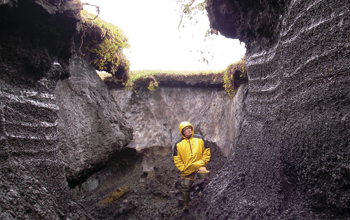Multimedia Gallery
Glacial Ice Discovery at Kaktovik, Alaska (Image 3)
Yuri Shur, a University of Arkansas, Fayatteville (UAF), professor, is dwarfed by the bluffs of a glacial exposure at the village of Kaktovik, Alaska. Shur was part of a group of Alaska EPSCoR (Experimental Program to Stimulate Competitive Research) researchers who discovered the glacial ice in a massive bluff along the beach near the village. A storm the previous month had torn off a large chunk of shoreline, exposing a vertical cross-section of the material beneath. The exposed area included frozen soil and massive ice more than a mile and a half long and between 20 and 35 feet high. Numerous deformed ice masses--some as large as 20 feet thick and 45 feet wide--were interspaced within it.
The discovery is significant because glacial ice had never been found this far north in Alaska--though similar ice has been found along the Beaufort Sea coast of Canada--and current maps of historic glaciers have them ending in the northern foothills of the Brooks Range, 50 miles south of the group's discovery.
The experienced researchers--all of which have extensively studied the ice at the base of Matanuska Glacier northeast of Anchorage extensively--were fairly certain they were looking at basil glacier ice. The exposed ice was far too wide to have originated from ice wedges (typically 10 feet wide or less) and the ice was brown and dirty due to salt and gravel mixed in it, in contrast to the clear, white ice formed by wedges.
The team brought ice samples and hundreds of photographs back with them to their universities for further study. Torre Jorgensen, an EPSCoR-affiliated physical science researcher who was part of the group that made the discovery, believes the Kaktovik glacier was part of an ice sheet that extended from the Canadian Arctic to Alaska's Northwest Arctic during the Late Pleistocene epoch. The ice sheet reached its fullest extent around 20,000 years ago before rapidly retreating 8,000 to 13,000 years ago. Jorgensen says there is evidence the sheet stretched as far west as Barrow on land and even farther to the west off the coast.
Matt Dillon, a graduate student at the University of Arkansas, will study the ice samples at the university using CAT scans, which will enable him to determine the samples' composition and compare them to ice from Matanuska and other glaciers. Although the researchers are considering a return trip to the site, the timeframe for further examination of the Kaktovik exposure is closing rapidly. Dillon points out that the bluffs had already begun to slump and collapse before the scientists left.
The discovery has implications beyond glaciology however. The distribution of sediments and permafrost characteristics across the North Slope will have to be reassessed and the prehistoric distribution of animals and human populations in the area will have to be reexamined. [Research supported by NSF grant EPS 07-01898.] (Date of Image: August 2008) [Image 3 of 3 related images. Back to Image 1.]
Credit: Tom Moran, Alaska EPSCoR
See other images like this on your iPhone or iPad download NSF Science Zone on the Apple App Store.
Images and other media in the National Science Foundation Multimedia Gallery are available for use in print and electronic material by NSF employees, members of the media, university staff, teachers and the general public. All media in the gallery are intended for personal, educational and nonprofit/non-commercial use only.
Images credited to the National Science Foundation, a federal agency, are in the public domain. The images were created by employees of the United States Government as part of their official duties or prepared by contractors as "works for hire" for NSF. You may freely use NSF-credited images and, at your discretion, credit NSF with a "Courtesy: National Science Foundation" notation.
Additional information about general usage can be found in Conditions.
Also Available:
Download the high-resolution JPG version of the image. (2.9 MB)
Use your mouse to right-click (Mac users may need to Ctrl-click) the link above and choose the option that will save the file or target to your computer.

